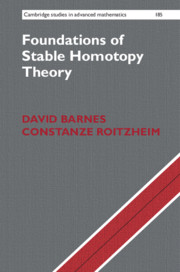Book contents
- Frontmatter
- Contents
- Introduction
- 1 Basics of Stable Homotopy Theory
- 2 Sequential Spectra and the Stable Homotopy Category
- 3 The Suspension and Loop Functors
- 4 Triangulated Categories
- 5 Modern Categories of Spectra
- 6 Monoidal Structures
- 7 Left Bousfield Localisation
- Appendix Model Categories
- References
- Index
1 - Basics of Stable Homotopy Theory
Published online by Cambridge University Press: 09 March 2020
- Frontmatter
- Contents
- Introduction
- 1 Basics of Stable Homotopy Theory
- 2 Sequential Spectra and the Stable Homotopy Category
- 3 The Suspension and Loop Functors
- 4 Triangulated Categories
- 5 Modern Categories of Spectra
- 6 Monoidal Structures
- 7 Left Bousfield Localisation
- Appendix Model Categories
- References
- Index
Summary
Bousfield and Friedlander defined the stable homotopy category in terms of the homotopy category of a model category of spectra. We will construct this model category following an approach similar to Mandell-May-Schwede-Shipley based on sequential spectra. A sequential spectrum is a sequence of pointed topological spaces (and structure maps), thus, a natural candidate for an analogue of weak homotopy equivalences are those maps of spectra inducing a weak homotopy equivalence at every level. However, we will see that these levelwise weak homotopy equivalences are not sufficient to define a class of weak equivalences leading to a meaningful stable homotopy theory. A key ingredient is the definition of homotopy groups of spectra and their isomorphisms. This generalises the notion of stable homotopy groups of topological spaces that we encountered earlier. Making these isomorphisms the weak equivalences of sequential spectra will give us a construction of our desired stable homotopy category. We end the chapter with an introduction to the Steenrod algebra and the Adams spectral sequence.
Keywords
- Type
- Chapter
- Information
- Foundations of Stable Homotopy Theory , pp. 7 - 36Publisher: Cambridge University PressPrint publication year: 2020

